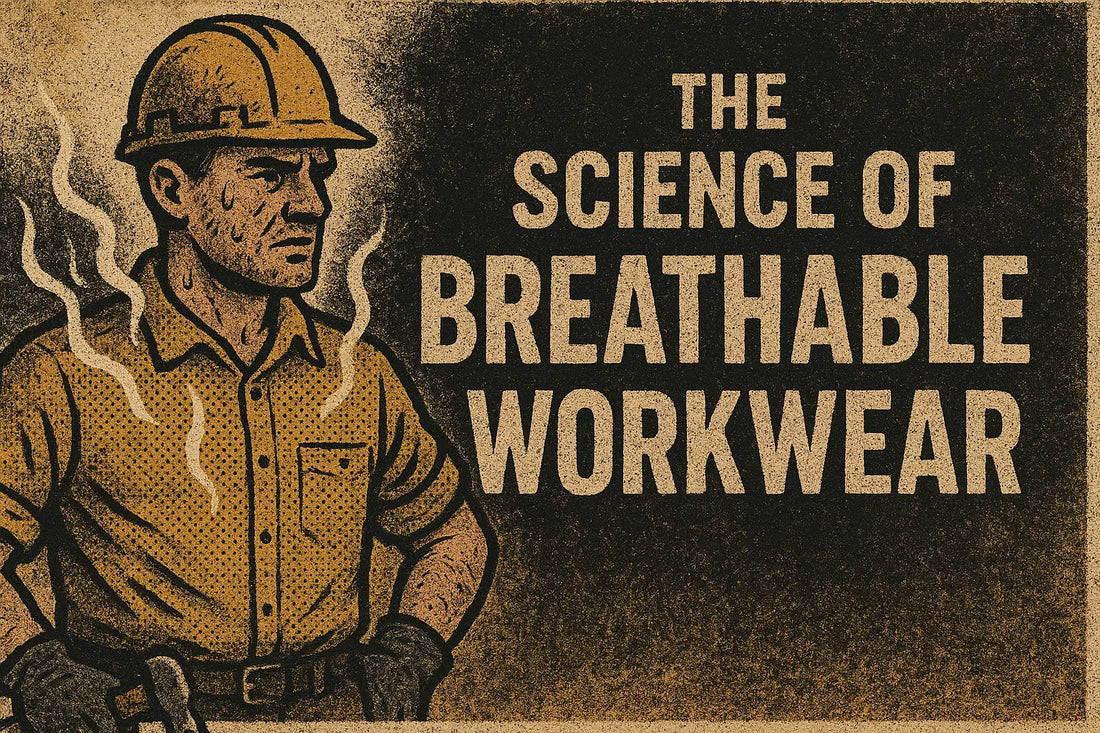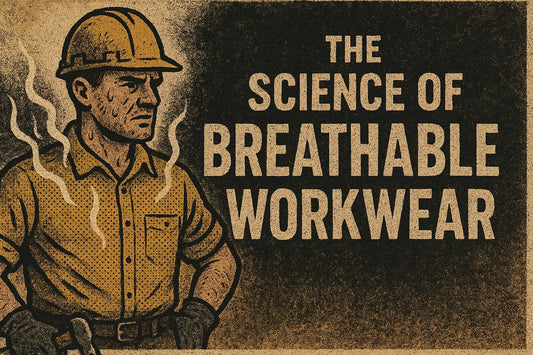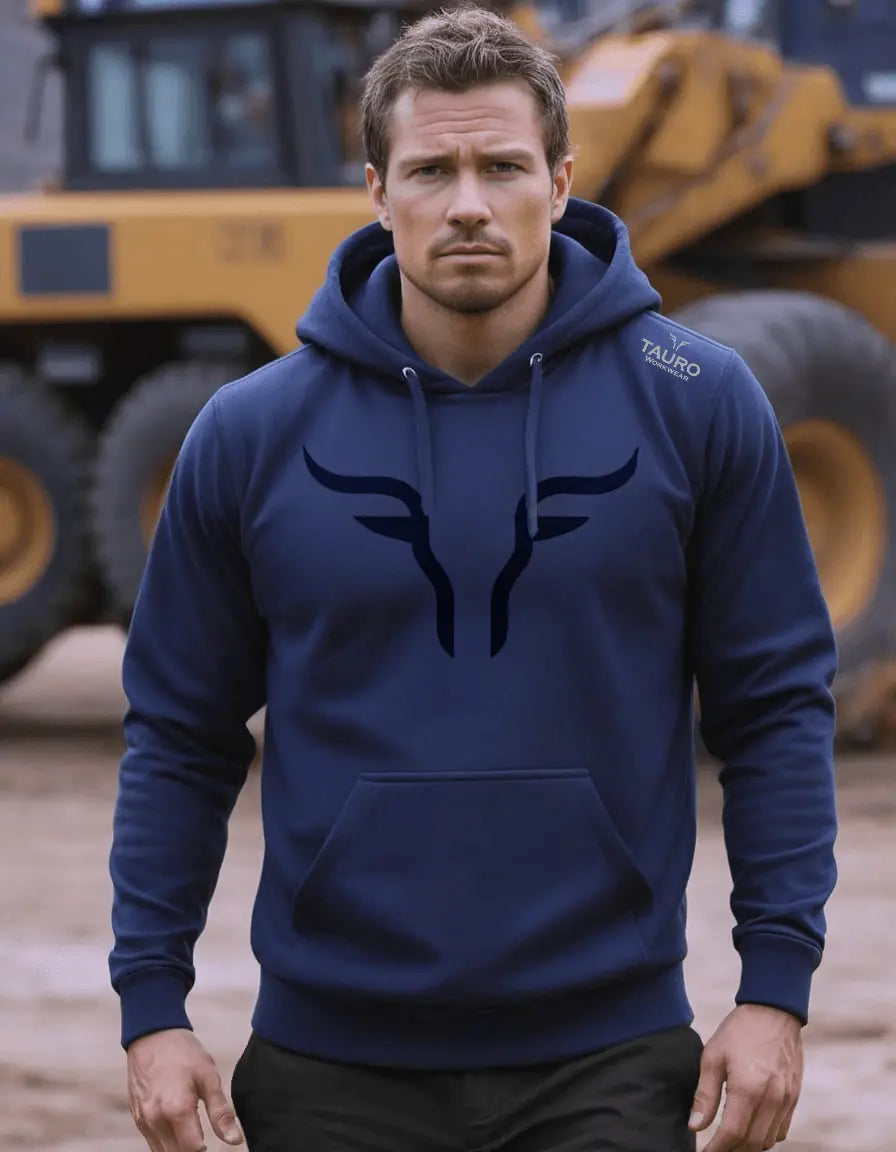
The Science of Breathable Workwear: Why Temperature Regulation Matters for Construction Workers
When you're grafting on a construction site under the scorching summer sun or working in poorly ventilated spaces, your choice of workwear can make the difference between a productive day and a miserable one. The science behind breathable workwear has evolved dramatically over recent years, transforming how builders and tradesmen approach comfort, safety, and performance on the job.
Modern construction demands more from workwear than ever before. Gone are the days when durability was the only consideration. Today's tradesmen need garments that can withstand the rigours of construction work whilst keeping them cool, dry, and comfortable throughout their shift. This comprehensive guide explores the fascinating world of breathable workwear technology and why it's becoming essential for every serious tradesman's kit.
Understanding the Science Behind Breathable Workwear
Breathable workwear isn't just about having a few extra ventilation holes sewn into your jacket. It's a sophisticated interplay of fabric technology, design engineering, and material science that creates garments capable of managing moisture, temperature, and airflow in challenging working conditions.
The foundation of breathable workwear lies in understanding how the human body regulates temperature during physical activity. When you're working hard, your body produces heat and moisture through perspiration. Traditional workwear fabrics like heavy cotton or basic polyester can trap this moisture against your skin, creating a clammy, uncomfortable environment that can lead to overheating, chafing, and reduced performance.
Did You Know? The average construction worker can produce between 1-3 litres of sweat per hour during intensive physical labour, depending on environmental conditions and work intensity.
Advanced breathable workwear addresses this challenge through three key mechanisms: moisture-wicking, vapour transmission, and strategic ventilation. These technologies work together to create a microclimate around your body that maintains optimal temperature and humidity levels, even during the most demanding tasks.
The Role of Moisture-Wicking Technology
Moisture-wicking fabrics represent one of the most significant advances in workwear technology. These materials use capillary action to transport sweat away from your skin to the fabric's outer surface, where it can evaporate quickly. The process relies on the fabric's fibre structure and chemical treatment to create a hydrophilic (water-attracting) inner surface and a hydrophobic (water-repelling) outer surface.
Research published in sustainable chemistry journals demonstrates that the most effective moisture-wicking fabrics can transport moisture in the Z-direction first, moving it away from the skin, before spreading it across the X and Y directions on the outer surface. This three-dimensional moisture management system is what separates premium breathable workwear from basic alternatives.
| Fabric Type | Moisture-Wicking Speed | Durability Rating | Breathability Score |
|---|---|---|---|
| Polyester Blends | Fast (2-4 minutes) | High | 8/10 |
| Merino Wool | Moderate (4-6 minutes) | Medium | 9/10 |
| Cotton Blends | Slow (8-12 minutes) | High | 4/10 |
| Synthetic Mesh | Very Fast (1-2 minutes) | Low | 10/10 |
The Health and Safety Benefits of Breathable Workwear
The importance of breathable workwear extends far beyond comfort. Poor temperature regulation can lead to heat stress, which affects cognitive function, reaction times, and decision-making abilities. For construction workers operating heavy machinery or working at height, maintaining optimal body temperature isn't just about comfort—it's a critical safety requirement.
Heat stress occurs when your body's cooling mechanisms can't keep up with heat production. Early symptoms include fatigue, irritability, and reduced concentration. As conditions worsen, workers may experience heat exhaustion or heat stroke, both of which can be life-threatening and require immediate medical attention.
Industry Statistics: The Health and Safety Executive reports that heat-related incidents in construction increase by 35% during summer months, with inadequate workwear being a contributing factor in over 60% of cases.
Breathable workwear helps prevent heat stress by maintaining your body's natural cooling mechanisms. When sweat can evaporate efficiently, your body temperature remains stable, reducing the risk of heat-related illness and maintaining your ability to work safely and effectively throughout your shift.
Impact on Productivity and Performance
Beyond safety considerations, breathable workwear has a measurable impact on productivity. Workers who remain comfortable throughout their shift maintain higher energy levels, better focus, and improved morale. This translates to higher quality work, fewer mistakes, and better overall job satisfaction.
Studies in occupational health have shown that workers wearing breathable workwear report 23% less fatigue at the end of their shift compared to those wearing traditional workwear. This reduction in fatigue correlates with improved accuracy in skilled tasks and better adherence to safety protocols.
Key Technologies in Modern Breathable Workwear
The breathable workwear market has seen rapid innovation in recent years, with manufacturers developing increasingly sophisticated solutions to meet the demands of construction professionals. Understanding these technologies helps you make informed decisions when selecting workwear that will genuinely improve your on-site experience.
Advanced Fabric Constructions
Modern breathable workwear utilises several advanced fabric technologies. Synthetic blends, particularly those incorporating polyester, offer excellent moisture-wicking properties whilst maintaining the durability required for construction work. These fabrics often feature engineered fibre structures that create channels for moisture transport whilst maintaining structural integrity.
Merino wool, whilst less common in construction workwear, offers natural breathability and odour resistance. The unique structure of wool fibres, with their hydrophilic interior and hydrophobic exterior due to natural lanolin, provides excellent moisture management properties. However, durability concerns often limit its use in high-wear applications.
Innovative fabric treatments also play a crucial role in breathable workwear performance. Antimicrobial treatments prevent odour-causing bacteria from building up in the fabric, whilst advanced polymer treatments can enhance moisture-wicking properties without compromising fabric feel or durability.
Strategic Ventilation Systems
Beyond fabric technology, the design and construction of breathable workwear incorporates strategic ventilation systems. These might include mesh panels in high-sweat areas, zippered vents that can be opened or closed based on conditions, and engineered seam placement that promotes airflow.
The most effective ventilation systems consider the natural airflow patterns created by body movement and work activities. Vents placed along the back, under the arms, and along the sides of garments can create a chimney effect that draws warm air away from the body whilst allowing cooler air to circulate.
Experience the Difference
Discover how advanced breathable workwear can transform your working day. Our range combines cutting-edge fabric technology with construction-specific design features.
Explore Our Breathable TrousersChoosing the Right Breathable Workwear for Your Trade
Different construction trades have varying requirements for breathable workwear. Roofers working in direct sunlight need maximum ventilation and UV protection, whilst those working in dusty environments require fabrics that resist particle penetration whilst maintaining breathability.
Understanding your specific working conditions is crucial when selecting breathable workwear. Consider factors such as typical temperature ranges, humidity levels, physical activity intensity, and environmental hazards. This assessment will help you identify the most appropriate fabric technologies and design features for your needs.
Seasonal Considerations
Breathable workwear needs change throughout the year. Summer clothing should prioritise maximum ventilation and moisture-wicking capability, whilst winter garments need to balance breathability with insulation and weather protection. Many modern workwear systems use layering principles, allowing you to adjust your clothing system based on conditions.
The concept of base layers, mid-layers, and outer shells, borrowed from outdoor sports, is increasingly relevant in construction workwear. A moisture-wicking base layer manages sweat, an insulating mid-layer provides warmth, and a breathable outer shell protects against wind and rain whilst allowing moisture vapour to escape.
The Economic Benefits of Investing in Quality Breathable Workwear
Whilst premium breathable workwear may represent a higher initial investment, the long-term economic benefits are substantial. Reduced heat stress leads to fewer sick days, improved productivity translates to better earning potential, and the durability of quality garments means lower replacement costs over time.
For self-employed tradesmen, the ability to work comfortably in challenging conditions can be the difference between completing a job on schedule and facing delays due to heat-related downtime. This reliability has a direct impact on reputation and earning potential.
Cost Analysis: Quality breathable workwear typically costs 20-40% more than basic alternatives but can reduce heat-related downtime by up to 50%, resulting in significant productivity gains.
Durability and Longevity
Modern breathable workwear is engineered to maintain its performance characteristics throughout its working life. Advanced fabric treatments and construction techniques ensure that moisture-wicking properties don't deteriorate with washing, and ventilation systems remain effective despite the wear and tear of daily use.
When evaluating the cost-effectiveness of breathable workwear, consider the total cost of ownership rather than just the initial purchase price. Factor in washing requirements, replacement frequency, and the indirect costs of discomfort and reduced productivity.
Care and Maintenance of Breathable Workwear
Proper care and maintenance are essential for preserving the performance characteristics of breathable workwear. Unlike traditional work clothes, breathable garments require specific washing and drying procedures to maintain their moisture-wicking and ventilation properties.
Most breathable workwear should be washed in cool water with mild detergent, avoiding fabric softeners that can clog the fibre structure and reduce moisture-wicking effectiveness. Tumble drying on low heat or air drying is generally recommended, as high heat can damage synthetic fibres and reduce breathability.
Regular inspection of ventilation systems, particularly zippered vents and mesh panels, helps identify potential issues before they compromise garment performance. Simple maintenance tasks like cleaning mesh panels and ensuring zippers operate smoothly can significantly extend the working life of breathable workwear.
Industry Trends and Future Developments
The breathable workwear industry continues to evolve, with manufacturers investing heavily in research and development. Current trends include the integration of smart textiles that can adapt to changing conditions, enhanced antimicrobial treatments, and sustainable fabric options that don't compromise performance.
Emerging technologies such as phase-change materials, which can absorb and release heat based on body temperature, are beginning to appear in premium workwear lines. These materials offer the potential for even more sophisticated temperature regulation in challenging working conditions.
Future Innovation: Research into bio-inspired fabric structures, based on natural cooling mechanisms found in plants and animals, promises to deliver even more effective breathable workwear solutions in the coming years.
The integration of IoT technology into workwear is another developing trend, with smart sensors capable of monitoring body temperature, humidity levels, and environmental conditions. This data can provide valuable insights into workwear performance and help optimise garment selection for specific conditions.
Environmental Considerations
As environmental awareness grows within the construction industry, the sustainability of breathable workwear has become an important consideration. Manufacturers are developing eco-friendly alternatives to traditional synthetic fabrics, including recycled polyester blends and biodegradable moisture-wicking treatments.
The durability of quality breathable workwear contributes to its environmental credentials. Garments that last longer and maintain their performance characteristics reduce the need for frequent replacement, lowering overall environmental impact. When selecting breathable workwear, consider manufacturers who demonstrate commitment to sustainable practices and offer recycling programmes for worn-out garments.
Making the Right Choice for Your Business
Whether you're a sole trader or managing a large construction crew, the benefits of breathable workwear extend beyond individual comfort. Teams equipped with appropriate breathable workwear demonstrate better performance, higher morale, and improved safety records. These factors contribute to business success and help attract and retain skilled workers.
When specifying workwear for your team, consider the diverse needs of different roles and working conditions. A comprehensive approach might include lightweight breathable shirts for groundworkers, ventilated jackets for machine operators, and high-performance base layers for all team members.
The investment in quality breathable workwear demonstrates commitment to worker welfare and professional standards. This investment pays dividends in terms of productivity, safety, and business reputation. Clients and partners increasingly recognise the professionalism demonstrated by well-equipped construction teams.
Transform Your Team's Performance
Equip your workforce with breathable workwear that enhances comfort, safety, and productivity. Our trade-specific solutions are designed for the unique demands of construction work.
Explore Our Breathable Workwear TrousersConclusion: The Future of Construction Workwear
The science of breathable workwear represents a fundamental shift in how we approach construction clothing. No longer is it sufficient to simply protect against hazards; modern workwear must actively enhance performance, comfort, and safety. The technologies and design principles explored in this guide demonstrate that breathable workwear isn't a luxury—it's an essential tool for professional construction work.
As climate change brings more extreme weather conditions and construction projects become increasingly demanding, the importance of effective temperature regulation will only grow. Breathable workwear provides a practical solution that addresses these challenges whilst improving the daily experience of construction workers.
The investment in quality breathable workwear pays dividends in terms of health, safety, productivity, and professional satisfaction. For serious tradesmen who take pride in their work and value their wellbeing, breathable workwear represents the logical evolution of construction clothing.
As we look towards the future, continued innovation in fabric technology, design engineering, and smart textiles promises even more sophisticated solutions. The construction industry's embrace of breathable workwear reflects a broader recognition that worker comfort and performance are inseparable from project success.
Frequently Asked Questions
Ready to Experience the Difference?
Join thousands of construction professionals who've already discovered the benefits of advanced breathable workwear. Our expert team can help you select the perfect garments for your specific needs and working conditions.
Explore Our Breathable Work Trousers




